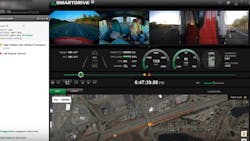SmartDrive Systems, a leader in driving performance solutions that reduce collisions and improve fuel efficiency, announced at the National Private Truck Council (NPTC) Annual Conference and Exhibition (April 30-May 2 in Cincinnati, OH) new capabilities that extend the value of SmartDrive 360, the company’s solution that enables fleets to deploy additional cameras to gain 360-degree insight into risk.
In this latest release, SmartDrive 360 expands its on-demand video capability with triggering on up to four cameras simultaneously based upon high-risk maneuvers—providing better insight into frequent causes of collisions and clearly exonerating drivers in all collision types. SmartDrive was previously awarded a patent for Advanced System Triggering with a patent pending for this latest innovation. In addition to delivering an unprecedented level of coverage, SmartDrive 360 provides the fastest insight to risk. Offloaded in minutes and, in most cases, reviewed by an expert driving analyst within one hour, confirmed collisions and alerts are sent to customers so they can react swiftly to the incident. This immediate access to video allows fleets to improve their safety programs, reduce claims processes and increase safety measures.
“SmartDrive customers are an integral part of our innovation process,” stated Steve Mitgang, CEO of SmartDrive. “Working together, we took SmartDrive 360 to the next level by taking advantage of the safety technology investments our customers have already made.
Since 35 percent of collisions are side and rear incidents, a growing number of fleets are adding more cameras to their trucks. By capturing triggered video across these additional cameras, fleets can now gain immediate visibility to the highest risk—and most costly events—in and around their vehicles.”
The new SmartDrive 360 multi-camera triggering makes it easy for customers to quickly access and view the complete picture of high-risk events. When a vehicle with SmartDrive 360 experiences a risky maneuver, such as swerve, U-turn, high impact/collision, or the driver initiates a manual recording, video is captured from all four cameras. The video is then automatically offloaded from the SmartRecorder, along with the in-cab and forward-facing camera views. Previously, these videos were only available on-demand. Now, the immediacy of these videos allow fleets to get expanded insight on those incidents where it matters most, delivering on a main tenet of the SmartDrive Promise: “We deliver video in minutes, not days.”
An example of SmartDrive 360 in action can be seen here. In this video, the SmartRecorder captures an alert driver who is required to swerve to avoid a collision with a car; he also skillfully avoids a car in the next lane. He is doing everything right on the road, and has full protection with the SmartDrive program. The extra eyes on the road—and around the vehicle—that SmartDrive 360 provides delivers additional driving context for executives and fleet management.
Reinforcing the ease of fleets to include SmartDrive 360 as part of their video-based safety solution, Mitgang comments, “This new capability is available without a costly hardware ‘rip-and-replace’. This points to the power of our open platform, which continues to pay dividends to customers and takes advantage of their other safety investments.”
Whereas just a few years ago, fleets were reticent to install one camera, the adoption of multiple cameras is rapidly increasing as fleets move to proactively identify risk. The ability to have an expansive view of the vehicle in its operating environment helps ensure safety in fleets that drive in congested areas (such as food/beverage and distribution/delivery) that routinely face sideswipe incidents, compliance-heavy industries where operational procedures need to be meticulously followed and fleets driving specialty equipment.
“Not only have our drivers fully embraced the SmartDrive video-based safety program, but they also recognize that additional cameras equal more protection for them in collisions or other incidents where they are not at fault,” said Michael Lasko, safety manager, T.F. Boyle Transportation. “Additional video from different areas around the vehicle gives us a deeper understanding of what happens on the road and which drivers need coaching to improve safety.”


